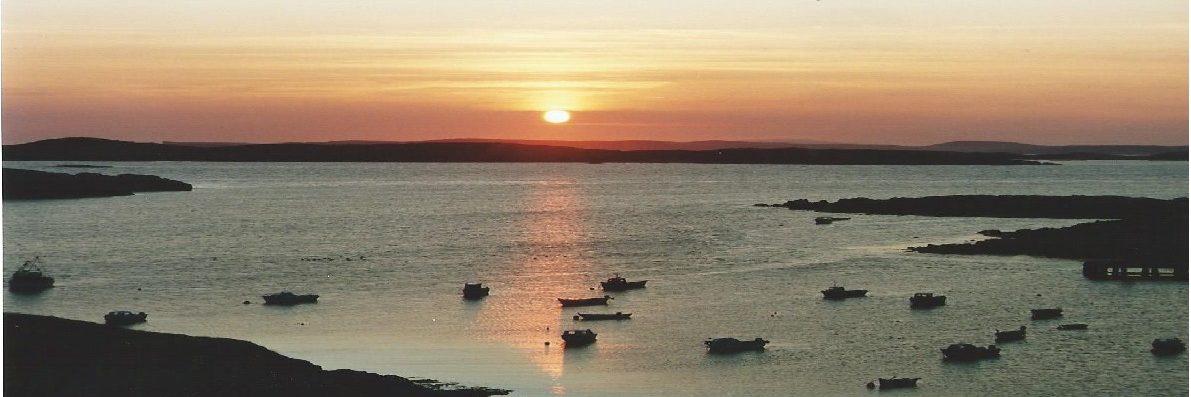My grandfather’s croft consisted of a small park which was fenced in where he kept perhaps a dozen ewes. The remainder of his flock roamed the village. I fondly remember hand feeding his sheep especially in the winter when grazing was scarce. One particular Shetland ewe “Blackie“ would come into our house and I would brush the snow off her fleece while hand feeding her. As Island life was predominately based around fishing the crofts and sheep numbers were relatively small, the returns from crofting were sparse, and livestock was mainly used to supplement the needs of the family. This included their fine wool.

It wasn’t until I was 10 years old and had the good fortune to meet up with my Uncle Willie Robertson’s family, who lived in the North East of Shetland in Vidlin, that I came to understand the importance of traditional crofting life its impact on a rural community and the comradeship of crofters. My summer months were spent on the Robertson croft at Kirkabister in Vidlin and it was here my education of Shetland agriculture and in particular Shetland sheep and wool began.

A highlight of my summer was gathering or “caaing“ the hill sheep. As many as a dozen crofters would set off with their dogs from different parts of the district, which was very hilly and full of gullies and burns. I marvelled at how they all seemed to meet up at a certain location, most often next a loch, and drive the mass of sheep into the “cro” (pen). Here each crofter would select out their own sheep and start hand shearing or in some cases “rooing“ (plucking) their animals. I began to know how each crofter could distinguish who owned the sheep. This was done by “lug“ earmarks, where each crofter had their own “brand“. A favourite memory of mine was at one of the larger gatherings, I spotted one of the Robertson family’s black ewes being shorn by a distant neighbour and telling the Johnson brothers, who were representing the crofter who owned the ewe of what was about to happen I asked if they should point out the mistake they said no just wait and when the crofter had finished, they went and said thanks for shearing one of the Robertson sheep and took the fleece and handed it to me to pack!

In Vidlin I learned the art of shearing the sheep by hand and also how to “roo” the fleece off the sheep. This was fairly easy with the Shetland sheep as in the summer months the new wool would rise causing the old wool to lift and making it easy for the wool to come off the sheep. Having exceptionally fine wool made it easy for the sheep to shed its wool and in many cases when the sheep put on condition it would make this easier to happen. Crofters entering a sheep, especially rams at a local agricultural show would “roo” the sheep giving it a better finished coat much more even in the staple. People used to go and gather the “cast off” wool known locally as “hentilagets” and sell it or trade it for yarn.




I am very grateful to Morag Hay who was brought up in a farming and crofting environment and involved in agriculture all her young life for most of the images accompanying this blog it shows her families involvement with some aspects of sheep husbandry in the 1950s/60s.


A lovely glimpse into both your history and that of crofting life. I’ve seen rooing of Shetland sheep before, as the owner was desperate to salvage the fleece that was about to blow off as a grey, wooly sail from the sheep’s back!
LikeLike
Thank you for sharing your stories and history. Enjoying it very much.
LikeLike
Great hearing about your young life and how everyone came together to help.
LikeLike
Interesting pattern on the jumper!
LikeLike
Great article! I’ll be in shetland in 2 weeks!
LikeLike
Thank you so much for creating this blog. I live in the USA and knit and spin wool. I hope to make the journey to wool week in the next few years. I am throughly enjoying reading your blog posts. Thank you again for taking your precious time to create this for others. I am also an elementary educator and find the information and photos informative
for teaching children about sheep 🐑
LikeLike
You have Beautiful memories. Thank you so much for sharing. You have made my day X x
LikeLike
Thanks for sharing your beautiful photos and interesting history.
I have raised a small fiber flock of mostly Shetlands for about the past twenty five years. I am now down to only two, as I am sixty eight years old and worry who would take care of my sheep if I were to “kick the bucket”!
I love having sheep and shearing, spinning and hooking woolen rugs and pillows. My patterns are all original and made by me ( I am a watercolor artist).
I recently found out that my mothers ancestors were from Scotland ( around 1700s at least). I am planning a trip to Scotland once the Covid situation is doing better. Thank you for your very interesting articles and photos.
LikeLike
Thank you for your kind words. It is good to hear you keep Shetland sheep they are true characters. Perhaps some day when we return to normal you will pay us a visit. Take care and have a good Christmas and all the best for the New year. Oliver
LikeLike